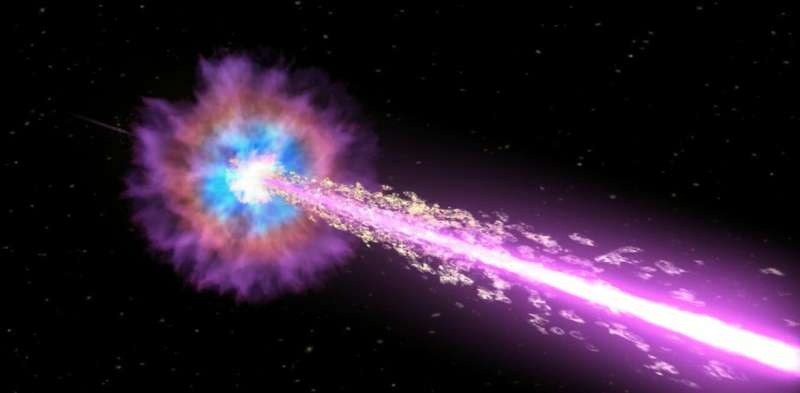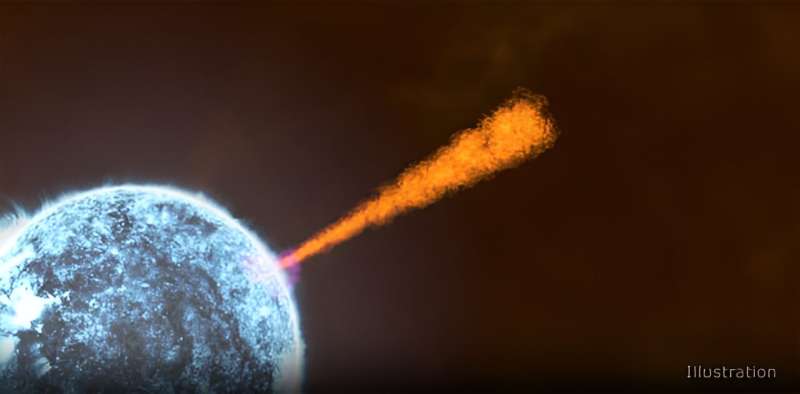
Credit: NASA/Swift/Cruz deWilde
After its “birth” during the Big Bang, the universe was mainly made up of hydrogen atoms and a few helium atoms. They are the lightest elements on the periodic table. More or less all the elements heavier than helium were produced in the 13.8 billion years between the Big Bang and the present day.
Stars produced many of these heavier elements through the process of nuclear fusion. However, this only makes the elements as heavy as iron. Creating heavier elements would consume energy instead of releasing it.
To explain the presence of these heavier elements today, we must find the phenomena that can produce them. One type of event that fits perfectly is the gamma-ray burst (GRB), the most powerful class of explosion in the universe. These can flare with a quintillion (10 followed by 18 zeros) times the luminosity of our sun, and are thought to be caused by several types of events.
GRBs can be subdivided into two categories: long bursts and short bursts. Long GRBs are associated with the death of massive, rapidly rotating stars. According to this theory, rapid rotation throws material ejected during the collapse of a massive star into narrow jets that move at extremely fast speeds.
The short bursts last only a few seconds. They are thought to be caused by the collision of two neutron stars, compact and dense “dead” stars. In August 2017, a significant event helped support this theory. Ligo and Virgo, two gravitational wave detectors in the United States, discovered a signal that appeared to come from two neutron stars heading toward a collision.
Seconds later, a short gamma-ray burst, known as GRB 100817A, was detected coming from the same direction in the sky. For a few weeks, virtually every telescope on the planet pointed toward this event in an unprecedented effort to study its consequences.
Observations revealed a kilonova at the location of GRB 170817A. A kilonova is a fainter cousin of a supernova explosion. Even more interesting, there was evidence that many heavy elements had been produced in the explosion. The authors of a study in Nature who analyzed the explosion showed that this kilonova appeared to produce two different categories of debris, or ejecta. One was composed mainly of light elements, while another was composed of heavy elements.
We’ve already mentioned that nuclear fission can only produce elements as heavy as iron on the periodic table. But there is another process that could explain how the kilonova was able to produce even heavier ones.

A jet of particles pierces a star as it collapses into a black hole. Credit: NASA Goddard Space Flight Center
The rapid neutron capture process, or R-process, is the process in which the cores (or cores) of heavier elements such as iron capture many neutron particles in a short time. Their mass then increases rapidly, producing much heavier elements. However, for the R process to work, you need the right conditions: high density, high temperature, and a large number of available free neutrons. Gamma-ray bursts provide these necessary conditions.
However, mergers of two neutron stars, like the one that caused the kilonova GRB 170817A, are very rare events. In fact, they might be so rare that they would be an unlikely source of heavy elements abundant in the universe. But what about long GRBs?
A recent study studied in particular a long gamma-ray burst, GRB 221009. This has been nicknamed the BOAT, the brightest of all time. This GRB was captured as a pulse of intense radiation sweeping across the solar system on October 9, 2022.
The BOAT launched an astronomical observation campaign similar to that of the kilonova. This GRB was 10 times more energetic than the previous record holder, and so close to us that its influence on Earth’s atmosphere was measurable on the ground and comparable to a major solar storm.
Among the telescopes studying the consequences of BOAT was the James Webb Space Telescope (JWST). He observed the GRB approximately six months after its explosion, so as not to be blinded by the afterglow of the initial explosion. Data collected by JWST showed that, despite the extraordinary brightness of the event, it was due to a merely average supernova explosion.
In fact, previous observations of other long GRBs indicated that there was no correlation between the brightness of the GRB and the size of the supernova explosion associated with it. The BOAT seems to be no exception.
The JWST team also deduced the number of heavy elements produced during the BOAT explosion. They found no indication of elements produced by the r process. This is surprising because, in theory, the brightness of a long GRB is thought to be associated with the conditions in its core, most likely a black hole. For very bright events – especially one as extreme as BOAT – the conditions should be right for the r-process to occur.
These results suggest that gamma-ray bursts may not be the hoped-for crucial source of the universe’s heavy elements. Instead, there must be one or more sources still available.
Provided by The Conversation
This article is republished from The Conversation under a Creative Commons license. Read the original article.![]()
Quote: The biggest explosions in the universe created the elements we are made of, but there is another mysterious source (June 1, 2024) retrieved June 2, 2024 from https://phys.org/news/2024-05- universe-biggest-explosions-mystery-elements.html
This document is subject to copyright. Except for fair use for private study or research purposes, no part may be reproduced without written permission. The content is provided for information only.